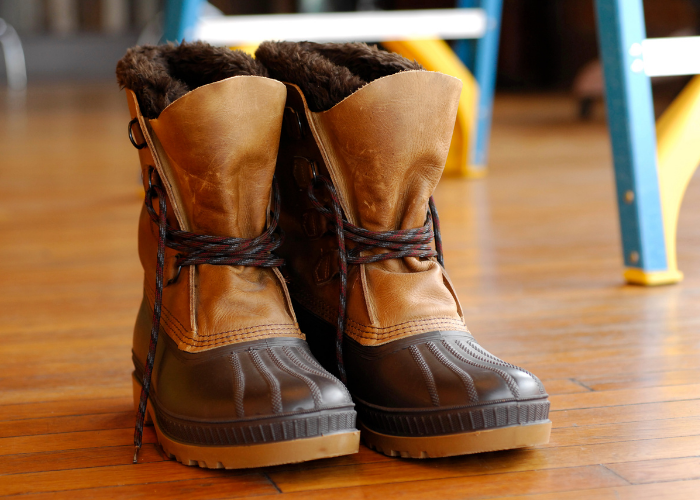
With 2020 finally behind us, the promise of a better year glimmers before us all: Restaurants that are bursting at the seams with patrons (or at least that aren’t deserted), grandparents finally able to hug their grandchildren again, and—of
course—
beautiful, spotless hardwood floors. But first…we must make it through the winter.
While Basic Coatings® can’t help much on the first 2 fronts, we can help with the last. Here are 4 mistakes that many homeowners make during the winter months, along with remedies to ensure their hardwood floors make it through to March, unscathed
by moisture from snow, ice, and the salt used to combat them.
1. Dismissing Mats
Sturdy mats and rugs should be every homeowner’s first defense against salt and moisture. In fact, an effective matting system can trap 90% of debris.
- A coarse, sturdy mat should be placed right outside the home for the purpose of stomping off snow and dislodging salt particles before entering.
- Another mat or rug heavy enough to wipe shoes on should be placed directly inside the doorway to catch any remaining salt or moisture before it can be tracked into the house.
- Homeowners may also consider adding a third waterproof mat to the side of the door, where shoes can be placed to dry, as well as keeping towels handy to wipe up any wetness that makes its way onto floors.
2. Letting Moisture Linger
When liquid, slush, or ice is spotted resting on hardwood floors, homeowners should make every possible effort to remove it immediately, lest it seep into the floor and cause mold growth beneath the floor surface or warping of the floorboards.
- If the amount of liquid is excessive, a wet/dry vacuum may be the best tool to start. Homeowners, take heed, however, that utterly soaked wood may crack if it is dried too quickly.
- Heat should also be avoided during the drying process, as it can cause cupping, which is a type of warping where the edges of individual boards are raised higher than the center.
3. Shrugging off Salt
Most cold-weather salts or ice melt products are made from Calcium Chloride, which is popular due to its affordability and relative effectiveness.
- Calcium Chloride is crystalline, and the rough texture of each individual crystal—most visible under a microscope—has the potential to scratch and abrade wood floor finish if tracked inside and dragged across or ground into the floor.
- Homeowners should regularly vacuum floors to suck up these micro-abrasive particles, preferably with a vacuum that is made for hardwood. If equipped with a rotating brush, it should be off or removed entirely before vacuuming.
- When Calcium Chloride is dissolved in water, it creates Calcium Hydroxide and Hydrochloric Acid, both of which leave behind a noticeable white residue. If the residue is not promptly removed, it can chemically damage the finish, causing hazing
and premature degradation, which can also increase dirt embedment.
- If the residue is “fresh,” it can likely be removed with a damp (not wet) soft cloth. Older or more stubborn salt stains will require a thorough cleaning.
4. Cleaning with Whatever's in the Closet
After vacuuming over and around an older or more stubborn salt stain, it is important to thoroughly clean it.
- Homeowners may be advised by misguided friends or family to use a mixture of vinegar and water on salt stains. We advise those homeowners to let this “quick fix” go in one ear and out the other, as vinegar will leave a residue of its
own and is harsh on finish if concentrated too strongly.
- Homeowners should also resist the temptation to use the general cleaners or disinfectants they may already have on hand, and instead opt for a cleaner specifically formulated for finished floors. Otherwise, they risk damage from inappropriate
pH levels and ingredients, such as Hydrogen Peroxide, acids, Sodium Hypochlorite, etc.
Basic Coatings does have a 2-product solution to help homeowners safely remove salt stains while maintaining the finish on floors.
- Begin with I.F.T. (Intensive Floor Treatment) used according to
label directions.
- Finish with Squeaky™, again according to label directions.
- Both of these can be purchased directly from a local Basic Coatings hardwood flooring distributor. Please refer to our distributor locator here.
For larger spaces or excessive salt levels, our Dirt Dragon™ cleaning machine is designed to provide a risk-free and complete clean that mopping alone cannot, as well as suction excess water away from the floor surface. Many contractors own or have access to the Basic Coatings Dirt Dragon cleaning machine
and know the value of an annual deep cleaning. Please check reference our contractor locator for a list of local professionals who can provide an estimate to deep clean wood floors.
If homeowners avoid these 4 mistakes, they should be able to successfully avoid the perils of winter weather. If, however, severe damage is already present, homeowners may need to hire a professional to replace individual boards, fill in splintered
or corroded areas, or sand and refinish hardwood floors. To request a local Basic Coatings certified contractor contact you with more information about their services and pricing, please fill out the form here.